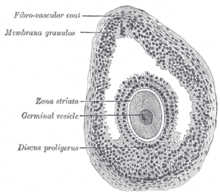Granulosa cell

A granulosa cell or follicular cell is a
Structure and function
In the primordial ovarian follicle, and later in follicle development (folliculogenesis), granulosa cells advance to form a multilayered cumulus oophorus surrounding the oocyte in the preovulatory or antral (or Graafian) follicle.
The major functions of granulosa cells include the production of
Embryology of ovarian granulosa cells

In the
The embryological origin of granulosa cells remains controversial. In the 1970s, evidence emerged that the first cells to make contact with the oogonia were of mesonephric origin. It was suggested that mesonephric cells already closely associated with the oogonia proliferated throughout development to form the granulosa cell layer.[2][3][4] Recently, this hypothesis has been challenged with some thorough histology. Sawyer et al. hypothesized that in sheep most of the granulosa cells develop from cells of the mesothelium (i.e., epithelial cells from the presumptive surface epithelium of the ovary).[5] In 2013, it was proposed that both granulosa cells and the ovarian surface epithelial cells are instead derived from a precursor cell called gonadal-ridge epithelial-like cell. [6]
Granulosa cell types
Cumulus cells (CC) vs mural granulosa cells (MGC)
Cumulus cells surround the oocyte. They provide nutrients to the oocyte and influence the development of the oocyte in a paracrine fashion. Mural granulosa cells line the follicular wall and surround the fluid-filled antrum. The oocyte secretes factors that determine the functional differences between CCs and MGCs. CCs primarily support growth and development of the oocyte whereas MGCs primarily serve an endocrine function and support the growth of the follicle. Cumulus cells aid in oocyte development and show higher expression of SLC38A3, a transporter for amino acids, and Aldoa, Eno1, Ldh1, Pfkp, Pkm2, and Tpi1, enzymes responsible for glycolysis.
Cell culture
Ovarian aging
In the female rhesus monkey, DNA double-strand breaks increase in granulosa cells with age, and the ability to repair such DNA breaks declines with age.[13] These changes at the DNA level in granulosa cells may contribute to ovarian aging.[13]
See also
- Granulosa cell tumour
- Ovulation
- Membrana granulosa
- List of human cell types derived from the germ layers
- List of distinct cell types in the adult human body
References
- PMID 6422764.
- PMID 1769902.
- S2CID 40498196.
- .
- S2CID 2271384.
- PMID 23409002.
- ^ Eppig, J. J., Pendola, F. L., Wigglesworth, K., & Pendola, J. K. (2005). Mouse oocytes regulate metabolic cooperativity between granulosa cells and oocytes: amino acid transport. Biology of reproduction, 73(2), 351-357.
- ^ Li, R., Norman, R. J., Armstrong, D. T., & Gilchrist, R. B. (2000). Oocyte-secreted factor (s) determine functional differences between bovine mural granulosa cells and cumulus cells. Biology of reproduction, 63(3), 839-845.
- ^ Diaz, F. J., Wigglesworth, K., & Eppig, J. J. (2007). Oocytes determine cumulus cell lineage in mouse ovarian follicles. Journal of cell science, 120(8), 1330-1340.
- ^ Khamsi, F., & Roberge, S. (2001). Granulosa cells of the cumulus oophorus are different from mural granulosa cells in their response to gonadotrophins and IGF-I. Journal of endocrinology, 170(3), 565-574.
- ^ Chen, L., Russell, P. T., & Larsen, W. J. (1993). Functional significance of cumulus expansion in the mouse: roles for the preovulatory synthesis of hyaluronic acid within the cumulus mass. Molecular reproduction and development, 34(1), 87-93.
- PMID 19324349.
- ^ a b Zhang D, Zhang X, Zeng M, Yuan J, Liu M, Yin Y, Wu X, Keefe DL, Liu L. Increased DNA damage and repair deficiency in granulosa cells are associated with ovarian aging in rhesus monkey. J Assist Reprod Genet. 2015 Jul;32(7):1069-78. doi: 10.1007/s10815-015-0483-5. Epub 2015 May 10. PMID: 25957622; PMCID: PMC4531862
External links
- Histology image: 18404loa – Histology Learning System at Boston University - "Female Reproductive System: ovary, cumulus oophorus"
- Histology image: 14808loa – Histology Learning System at Boston University - "Female Reproductive System: ovary, membrana granulosa"
- Granulosa+Cells at the U.S. National Library of Medicine Medical Subject Headings (MeSH)
